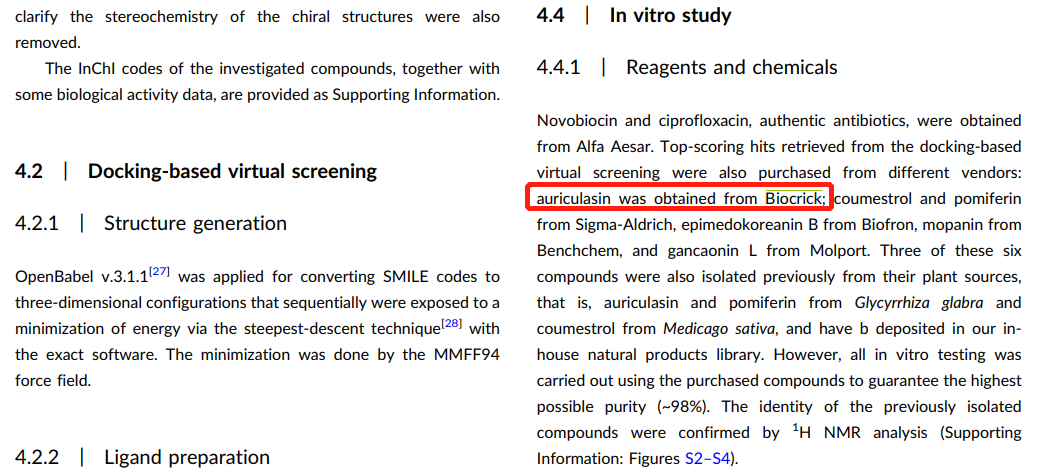Mechanistic study of the antibacterial potential of the prenylated flavonoid auriculasin against Escherichia coli
Arch Pharm (Weinheim). 2022 Dec;355(12)
PMID:36029269
 Bacterial resistance is spreading in an alarming manner, outpacing the rate of development of new antibacterial agents and surging the need for effective alternatives. Prenylated flavonoids are a promising class of natural antibiotics with reported activity against a wide range of resistant pathogens. Here, a large library of natural flavonoids (1718 structures) was virtually screened for potential candidates inhibiting the B-subunit of gyrase (Gyr-B). Twenty-eight candidates, predominated by prenylated flavonoids, appeared as promising hits. Six of them were selected for further in vitro antibacterial and Gyr-B enzyme inhibitory activities. Auriculasin is presented as the most potent antibacterial candidate, with a MIC ranging from 2 to 4 µg/ml against two clinically isolated multidrug-resistant Escherichia coli strains. Mechanistic antibacterial analysis revealed auriculasin inhibitory activity towards the Gyr-B enzyme on the micromolar scale (IC50 = 0.38 ± 0.15 µM). Gyr-B interaction was further detailed by conducting an isothermal titration calorimetric experiment, which revealed a competitive inhibition with a high affinity for the Gyr-B active site, achieved mostly through enthalpic interactions (ΔGbinding = -10.69 kcal/mol). Molecular modeling and physics-based simulations demonstrated the molecule's manner of fitting inside the Gyr-B active site, indicating a very potential nucleus for the future generation of more potent derivatives. To conclude, prenylated flavonoids are interesting antibacterial candidates with anti-Gyr-B mechanism of action that can be obtained from a plant-derived flavonoid.
Bacterial resistance is spreading in an alarming manner, outpacing the rate of development of new antibacterial agents and surging the need for effective alternatives. Prenylated flavonoids are a promising class of natural antibiotics with reported activity against a wide range of resistant pathogens. Here, a large library of natural flavonoids (1718 structures) was virtually screened for potential candidates inhibiting the B-subunit of gyrase (Gyr-B). Twenty-eight candidates, predominated by prenylated flavonoids, appeared as promising hits. Six of them were selected for further in vitro antibacterial and Gyr-B enzyme inhibitory activities. Auriculasin is presented as the most potent antibacterial candidate, with a MIC ranging from 2 to 4 µg/ml against two clinically isolated multidrug-resistant Escherichia coli strains. Mechanistic antibacterial analysis revealed auriculasin inhibitory activity towards the Gyr-B enzyme on the micromolar scale (IC50 = 0.38 ± 0.15 µM). Gyr-B interaction was further detailed by conducting an isothermal titration calorimetric experiment, which revealed a competitive inhibition with a high affinity for the Gyr-B active site, achieved mostly through enthalpic interactions (ΔGbinding = -10.69 kcal/mol). Molecular modeling and physics-based simulations demonstrated the molecule's manner of fitting inside the Gyr-B active site, indicating a very potential nucleus for the future generation of more potent derivatives. To conclude, prenylated flavonoids are interesting antibacterial candidates with anti-Gyr-B mechanism of action that can be obtained from a plant-derived flavonoid.
- Auriculasin
Catalog No.:BCN3970
CAS No.:60297-37-2


